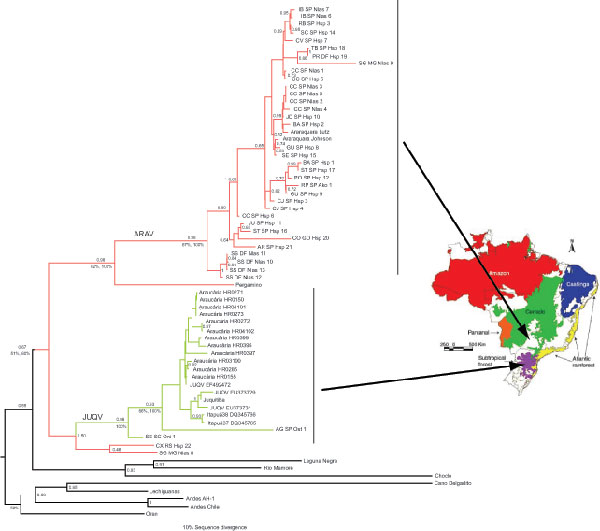Hantavirus Pulmonary Syndrome, Central Plateau, Southeastern, and Southern Brazil
Luiz T.M. Figueiredo

, Marcos L. Moreli, Ricardo L.M. de Sousa, Alessandra A. Borges, Glauciane G. de Figueiredo, Alex M. Machado, Ivani Bisordi, Teresa K. Nagasse-Sugahara, Akemi Suzuki, Luiz E. Pereira, Renato P. de Souza, Luiza T.M. de Souza, Carla T. Braconi, Charlotte M. Harsi, Paolo M. de Andrade Zanotto, and the Viral Diversity Genetic Network Consortium
Author affiliations: University of São Paulo School of Medicine, Ribeirão Preto, Brazil (L.T.M. Figueiredo, M.L. Moreli, R.L.M. de Sousa, A.A. Borges, G.G. de Figueiredo, A.M. Machado); Adolfo Lutz Institute, São Paulo, Brazil (I. Bisordi, T.K. Nagasse-Sugahara, A. Suzuki, L.E. Pereira, R.P. de Souza, L.T.M. de Souza); University of São Paulo, São Paulo (C.T. Braconi, C.M. Harsi, P.M. de Andrade Zanotto)
Main Article
Appendix Figure

Appendix Figure. Maximum clade credibility (MCC) tree based on concatenation of partial sequences of nucleocapsid (N) and glycoprotein genes of hantavirus detected in 16 patients with hantavirus pulmonary syndrome and in 15 rodents, and other South American hantaviruses. Arrows toward the map show that main biomes in Brazil indicate that Araraquara hantavirus (ARAV) samples (shown in red) had a distribution ranging mainly from the Central Plateau (cerrado, a savanna-like ecosystem) to areas bordering the Atlantic rain forest in southeastern Brazil. Juquitiba hantavirus (JUQV) samples (shown in green) were found in the southern part of Brazil and were associated with Atlantic rain forest and subtropical Araucaria forest. Nucleocapsid gene sequences clustered either with ARAV 100% of the time in the 500 best maximum likelihood (ML) trees for the data and 88% of the time in 500 independent nonparametric bootstrap iterations or with JUQV 100% of the time in the 500 best ML trees for the data and 60% of the time in 500 independent nonparametric bootstrap iterations.
Main Article
Page created: December 10, 2010
Page updated: December 10, 2010
Page reviewed: December 10, 2010
The conclusions, findings, and opinions expressed by authors contributing to this journal do not necessarily reflect the official position of the U.S. Department of Health and Human Services, the Public Health Service, the Centers for Disease Control and Prevention, or the authors' affiliated institutions. Use of trade names is for identification only and does not imply endorsement by any of the groups named above.
